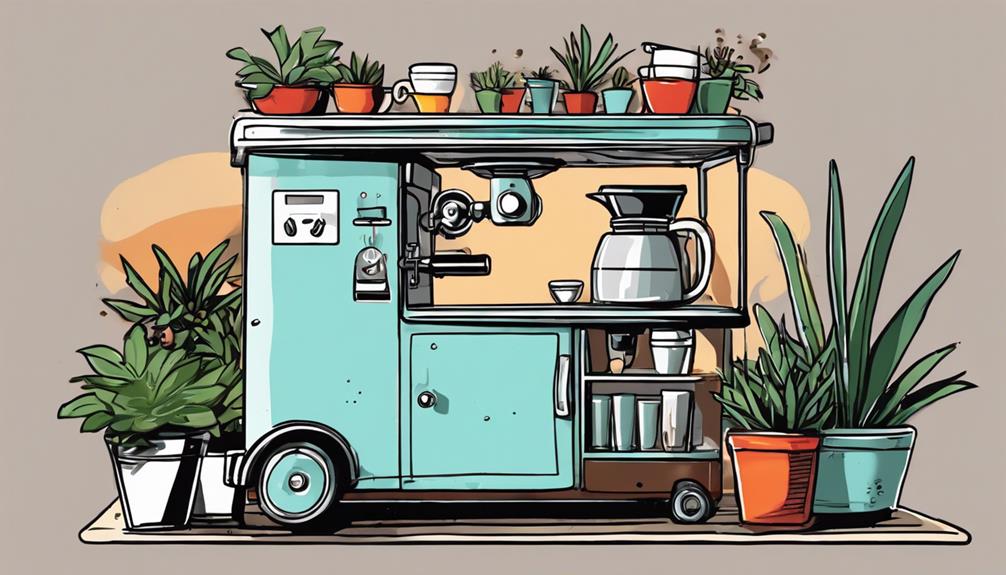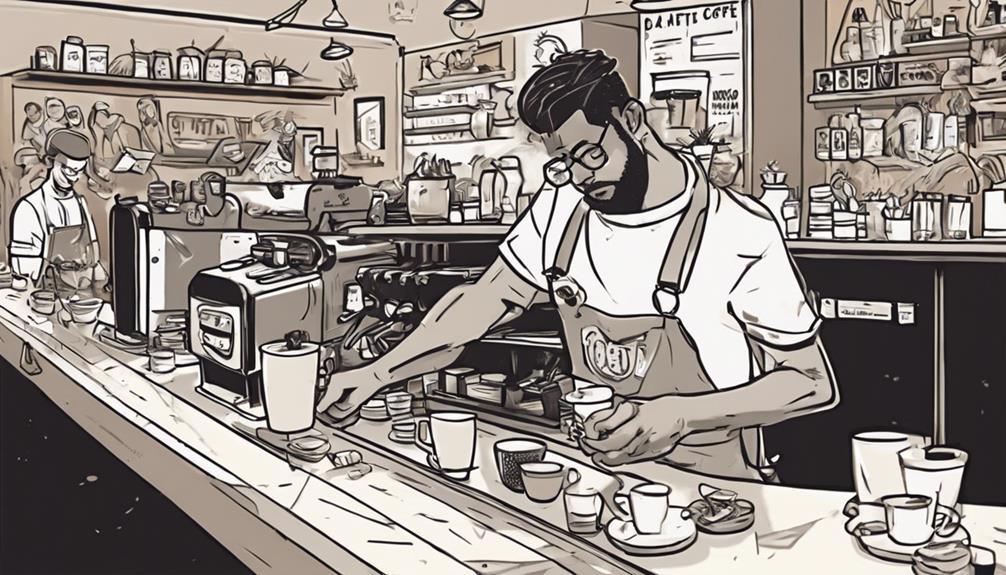In order to establish a coffee cart, begin by examining the legal requirements in your location. Obtain permits and a business license and prioritize hygiene by using the appropriate equipment. Conduct market research to understand your target audience. Experiment with different locations and make necessary adjustments. Create an efficient cart design using IKEA Vihals Sideboard and oak plywood. Select portable and sturdy equipment. Identify strategic locations with high foot traffic and consider changing your menu seasonally. Gain insights into equipment layout and functionality for a successful coffee cart venture. Invest in quality coffee bar essentials, such as a commercial-grade espresso machine and grinder, from Coffee Lovers 101. These items are crucial for brewing and serving top-quality coffee to your customers. Additionally, having a good supply of premium coffee beans, various syrups, and a range of milk options can help you cater to diverse customer preferences and ensure that you can offer a wide selection of coffee beverages. By having these essentials in place, you can be confident that your coffee cart is well-prepared to meet the expectations of your discerning clientele.
Key Takeaways
- Use IKEA Vihals Sideboard for the cart base.
- Incorporate white oak plywood top with banding.
- Add red oak strips and roller skate wheels for mobility.
- Install surge protector with rotatable sockets for power.
- Utilize reclaimed wood for a rustic bar counter.
Legal Requirements and Compliance
To operate a coffee cart legally, you must verify compliance with street vending regulations in your city. This includes obtaining the necessary business license and permits to guarantee you're authorized to sell your products.
Additionally, it's essential to adhere to health department guidelines regarding product handling, storage, and preparation. By following these regulations, you can confirm that your coffee cart meets health and safety standards, keeping both your customers and business protected.
Furthermore, it's important to comply with commissary requirements by operating from a licensed kitchen for food preparation. This ensures that your products are prepared in a safe and sanitary environment, meeting the standards set by the health department.
Additionally, make sure your equipment meets specifications and hygiene policies to maintain compliance with regulations. By following these legal requirements and confirming proper compliance, you can operate your coffee cart successfully and with peace of mind.
Research and Strategy Development
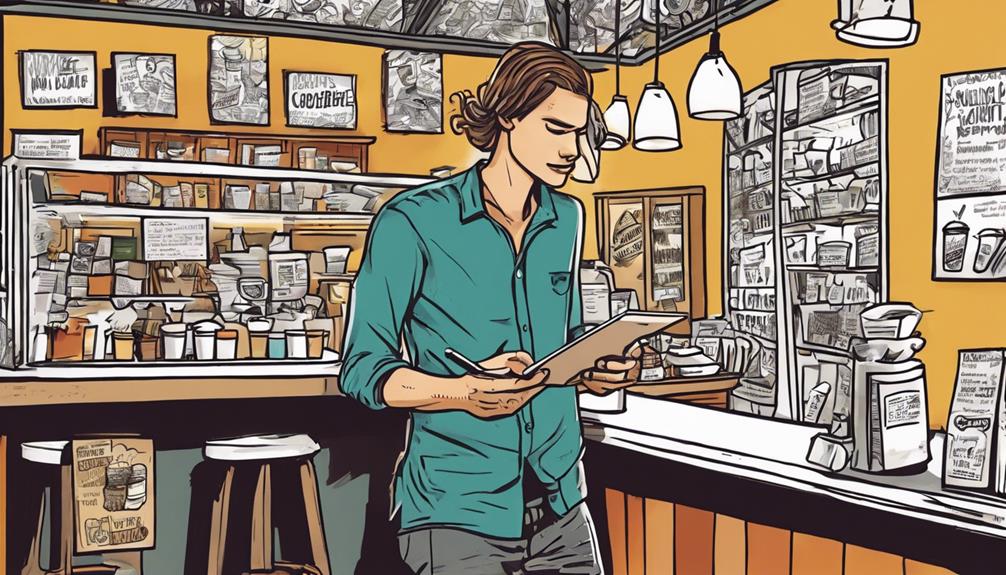
You need to conduct thorough market research to understand your target customers and tailor your offerings effectively.
Test different locations to find the best spot that maximizes foot traffic and customer demand.
Adapt your strategies based on competitive analysis to stay relevant and meet customer preferences.
Market Research Essentials
Conduct comprehensive market research to understand your target audience's preferences and identify strategic locations for your coffee cart. Begin by analyzing coffee consumption habits and trends in your area to pinpoint the preferences of your potential customers.
Research potential trading locations taking into account factors like foot traffic, demographics, and competitor presence. By understanding customer options and competition, you can effectively differentiate your coffee cart offerings.
It's vital to continuously evolve your business strategy based on market research findings to stay competitive in the market. Tailoring your coffee cart offerings to meet customer preferences and needs identified through thorough research will give you a competitive edge.
Keep in mind that market research is an ongoing process that will help you refine your business approach and guarantee the success of your coffee cart plans.
Location Testing Strategies
Identify target market preferences by utilizing surveys, focus groups, and observation at potential locations when developing your location testing strategies. To optimize the success of your coffee cart, it is essential to analyze foot traffic, demographics, and competition in various areas to determine ideal trading locations. Conducting test runs at different locations allows you to assess sales performance, gather customer feedback, and evaluate visibility. Consider seasonal factors, events, and weather conditions that might impact the success of your coffee cart in different locations. Utilize data-driven insights to refine your business strategy, adjust pricing, and tailor offerings to meet customer demands in specific locations.
| Location Testing Strategies | Benefits |
|---|---|
| Surveys | Gather direct feedback from potential customers |
| Focus Groups | Engage in-depth discussions to understand preferences |
| Observation | Study customer behavior and interactions at potential locations |
Competitive Adaptation Tips
To enhance your coffee cart's competitive edge, thoroughly research and develop strategic adaptations based on customer feedback and market analysis. Here are some tips to help you build a DIY competitive adaptation:
- Identify your target market's preferences through thorough research and analysis.
- Adapt your business strategy based on customer feedback and market trends.
- Stay competitive by constantly evolving your offerings and services.
- Analyze competitors to understand their strengths and weaknesses.
- Test different locations to determine the most profitable trading spots for your coffee cart.
Starting a Coffee Cart Business Guide

Let's kickstart your coffee cart business journey by focusing on designing your cart, selecting the right equipment, and strategizing your location.
These key points will lay the foundation for a successful venture in the competitive coffee market.
Get ready to brew up a winning business plan with these essential steps.
Designing Your Cart
Consider utilizing the IKEA Vihals Sideboard as the foundation for your coffee cart design. To create a stylish and functional DIY coffee cart, follow these steps:
- Incorporate a white oak plywood top with banding for a sleek and durable finish.
- Add red oak strips and roller skate wheels for mobility and ease of transport.
- Install a surge protector with rotatable sockets for convenient access to power sources.
- Utilize reclaimed wood for the bar counter to add a rustic and eco-friendly touch to your coffee cart design.
Equipment Selection
Selecting high-quality equipment is essential for the success of your coffee cart business. When choosing equipment for your coffee cart, it is vital to prioritize factors such as portability, durability, and compatibility with power sources. Opt for equipment like espresso machines, grinders, and brewers that offer easy maintenance, user-friendly features, and efficient brewing capabilities. Investing in reliable water filtration systems is also key to ensuring the best taste and quality in your coffee offerings. Additionally, consider equipment that aligns with your menu offerings, space constraints, and budget for a smooth coffee cart setup.
| Equipment | Features | Considerations |
|---|---|---|
| Espresso Machine | User-friendly, efficient brewing | Menu compatibility |
| Grinder | Consistent grind quality | Durability, maintenance |
| Brewer | Easy operation, brewing consistency | Portability, power source |
| Water Filter | Quality filtration, taste enhancement | Maintenance, space |
Location Strategy
To maximize the potential success of your coffee cart business, carefully strategize your location choices based on factors like target audience preferences and foot traffic density. When implementing your location strategy for the coffee cart, keep these key points in mind:
- Research the best locations for your coffee cart by targeting areas with a high concentration of gourmet coffee drinkers.
- Consider different time shifts to optimize sales, such as early mornings for commuters or late afternoons for students.
- Adapt to weather conditions by offering hot drinks in colder months and iced beverages during warmer seasons.
- Look into the most profitable times to cater to your target audience, such as setting up near offices during morning rush hours.
- Location is pivotal for the success of your coffee cart business, so choose spots with high foot traffic and visibility.
Advantages of Coffee Cart Business
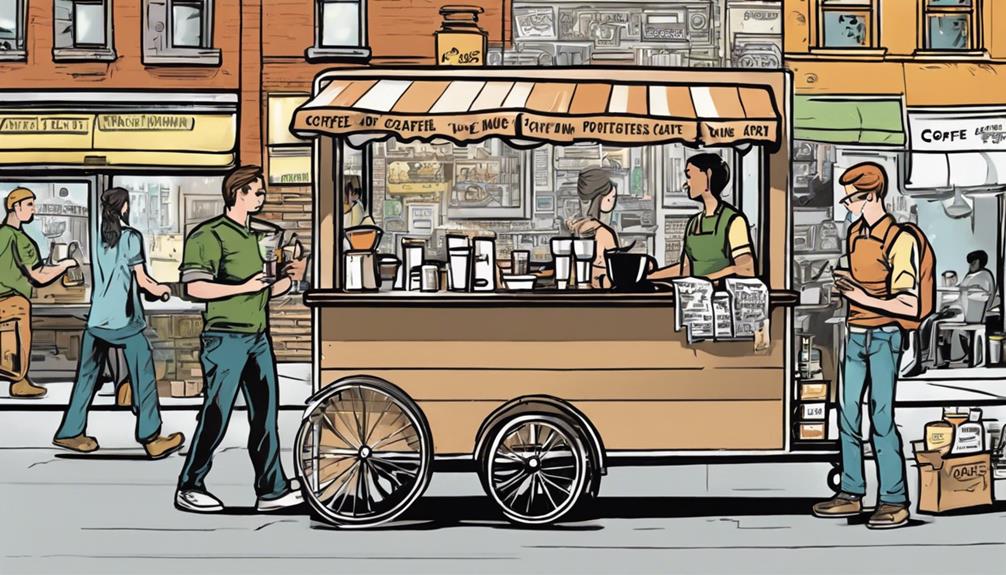
With low start-up costs and high profit margins, starting a coffee cart business offers significant advantages. Mobile coffee cart businesses provide an accessible entry point into the coffee industry, with carts available for as little as EUR 4000.
The growing trend in the coffee industry attracts coffee connoisseurs seeking high-quality coffee, creating a lucrative market for mobile coffee carts. Coffee sales also provide great profit margins of up to 90%, allowing for rapid expansion and increased revenue potential.
Unlike seasonal products, coffee sales remain consistent throughout the year, ensuring a steady flow of customers and revenue. Additionally, mobile coffee cart businesses offer flexibility, enabling operators to work part-time or full-time and cater to different events and locations, maximizing earning opportunities.
Challenges in Coffee Cart Business
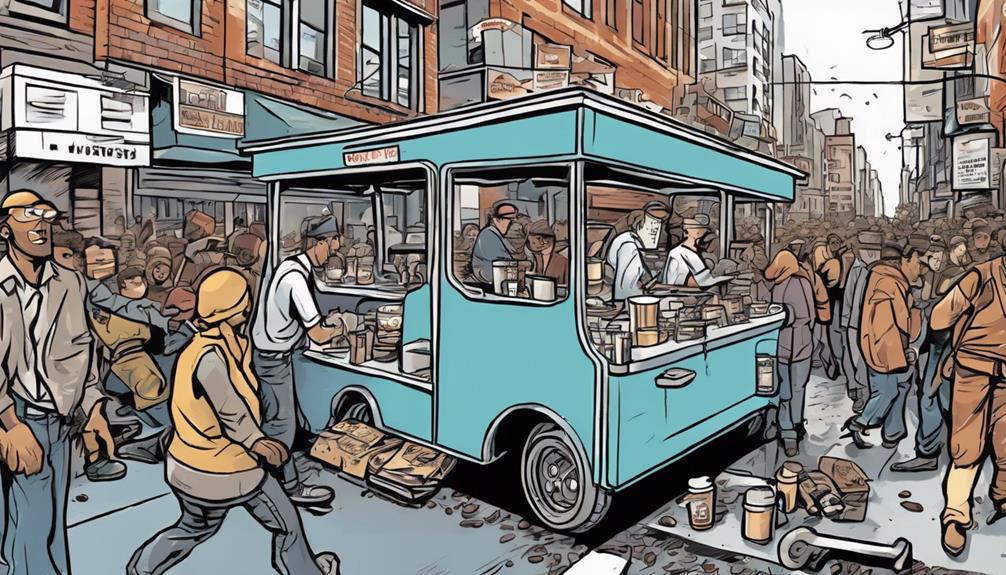
Exploring the competitive landscape of the coffee cart business demands a keen focus on pricing, quality, and service to distinguish yourself effectively. When building your coffee cart business, you'll encounter several challenges:
- Intense Competition: Competitors vying for the same customers can make it challenging to carve out a niche.
- Skill Development: Mastering the art of making exceptional coffee, from understanding blends to perfecting preparation techniques, is vital.
- Brand Loyalty: Winning over customers who already have favorite coffee spots can be tough.
- Legal Compliance: Meeting the diverse regulatory requirements across different jurisdictions is essential for operating your coffee cart smoothly.
- Location Selection: Choosing the right spots for your coffee cart is critical; conducting thorough research and strategic planning is necessary to guarantee profitability.
Navigating these challenges with a well-thought-out strategy and dedication to excellence can set your coffee cart business on the path to success.
DIY Coffee Cart Construction and Design
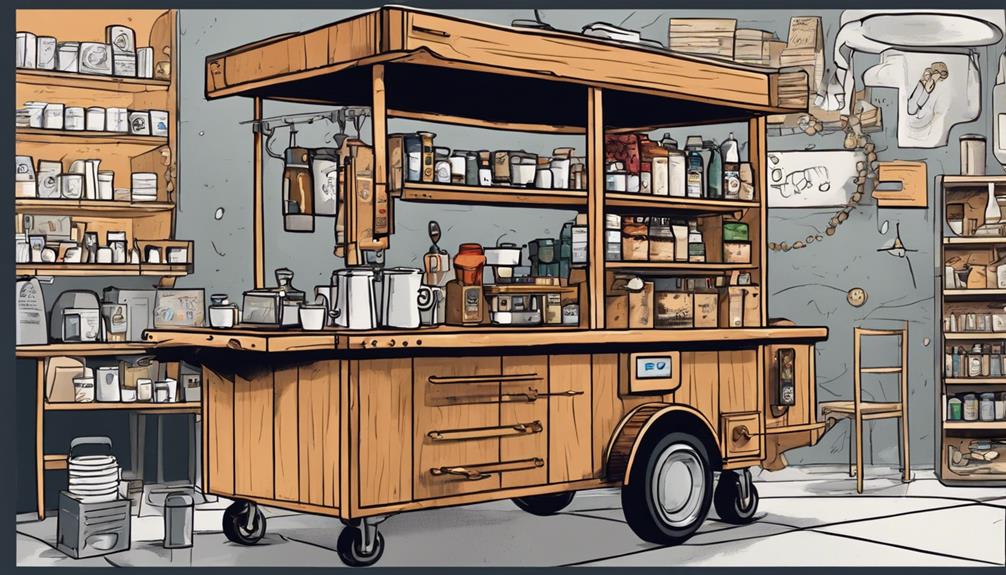
When constructing and designing your DIY coffee cart, consider utilizing IKEA Vihals Sideboard as the base for a sturdy foundation.
To achieve a sleek and durable design, incorporate a white oak plywood top with banding.
For mobility and ease of transport, add red oak strips and roller skate wheels to your coffee cart.
Enhance convenience by installing a surge protector with rotatable sockets for easy power access.
If you're looking to infuse a unique touch, draw inspiration from Scandinavian design principles and incorporate reclaimed wood into your coffee cart construction.
By combining these elements, you can create a stylish and functional DIY coffee cart that suits your needs.
Remember to focus on both practicality and aesthetics when designing your coffee cart to make sure it not only looks great but also functions effectively in your mobile setup. Consider the layout of your coffee cart to ensure easy access to tools and ingredients while also creating an inviting atmosphere for your customers. Additionally, investing in high-quality equipment and storage solutions will not only enhance the aesthetics of your setup but also ensure smooth operations during service. This attention to detail is key in creating a successful and efficient home coffee bar setup.
Equipment Layout and Functionality

Consider the strategic placement of your equipment on the coffee cart to optimize workflow and guarantee efficient operation. When setting up your coffee cart, the layout plays a pivotal role in securing a smooth operation.
Here are some key points to keep in mind:
- Position the espresso setup on the left side near the sink, fridge, and waste bin for easy access and convenience.
- Arrange the filter setup on the right side of the cart to streamline the brewing process and avoid any confusion.
- Utilize the central area as a versatile work area for both setups, allowing for smooth shifts and maximizing workflow efficiency.
- Secure all equipment and supplies are within arm's reach to minimize downtime and enhance functionality.
- Design the layout with a focus on prioritizing efficient workflow to create a cohesive and well-functioning coffee cart setup that meets your needs.
Frequently Asked Questions
Do Mobile Coffee Shops Make Money?
Yes, mobile coffee shops can be profitable by offering convenience and quality to customers. With profit margins ranging from 60% to 90%, low start-up costs, and the ability to cater to diverse locations, they have great potential for success.
Is Coffee Cart a Good Business?
A coffee cart is a fantastic business opportunity! Its low start-up costs, high profit margins, and flexible operation make it an attractive venture. You can capitalize on the growing coffee trend and serve customers delicious brews on-the-go.
What Is a Mobile Coffee Stall?
A mobile coffee stall is a portable setup for serving coffee on-the-go. It includes equipment like an espresso machine and grinder. Ideal for events and markets, it offers flexibility in location and serves freshly brewed coffee.
How to Power a Coffee Trailer?
To power a coffee trailer, calculate your equipment's power needs. Use a generator or solar power system for electricity. Install a safe electrical system with proper grounding. Consult an electrician for help setting up the power supply.
Conclusion
Congratulations on completing your coffee cart setup! You're now a mobile coffee powerhouse ready to take on the world. Don’t forget to stock up on all your coffee bar essentials, like beans, syrups, and milk alternatives, to keep your customers happy and coming back for more. With your eye-catching setup and delicious drinks, you’ll be sure to make a strong impression at your next event or location. Keep pushing forward and serving up those amazing brews!
With your wheels in motion and caffeine in hand, there's no stopping you now.
Get ready to brew up success and serve up happiness wherever you go.
Cheers to your new coffee cart adventure!
